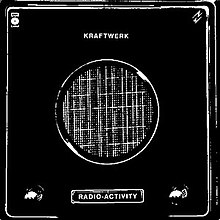Radio-Activity
| Radio-Activity | ||||
|---|---|---|---|---|
 |
||||
| Studio album by Kraftwerk | ||||
| Released | October 1975 | |||
| Recorded | 1975 | |||
| Studio |
Kling Klang Studio (Düsseldorf, Germany) |
|||
| Genre | ||||
| Length | 37:38 | |||
| Label | ||||
| Producer | ||||
| Kraftwerk chronology | ||||
|
||||
| Singles from Radio-Activity | ||||
|
||||
| Professional ratings | |
|---|---|
| Review scores | |
| Source | Rating |
| Allmusic | |
| Q | |
| Mojo | |
| Uncut | |
| Rolling Stone | not rated |
| Drowned in Sound | (8/10) |
Radio-Activity (German title: Radio-Aktivität) is the fifth studio album by German electronic band Kraftwerk, released in October 1975. Unlike Kraftwerk's later albums, which featured language-specific lyrics, only the titles differ between the English and German editions. A concept album, Radio-Activity is bilingual, featuring lyrics in both languages.
The album peaked at number one in France, becoming Kraftwerk's first album to reach a number one spot.
The hyphenated album title displays Kraftwerk's typical deadpan humour, being a pun on the twin themes of the songs, half being about radioactivity and the other half about activity on the radio. More word plays are evident in the track listing: "Radio Stars", which as a title could refer to pop stars, but upon listening is revealed to be about quasars and pulsars.
This was the first Kraftwerk album to be entirely self-produced by Ralf Hütter and Schneider in their Kling Klang studio, and the first one to be performed by the "classic" Hütter, Florian Schneider, Karl Bartos and Wolfgang Flür line-up. All the music was written by Hütter and Schneider, with Emil Schult collaborating on lyrics. Schult also designed the artwork – a modified illustration of a late-1930s 'Deutscher Kleinempfänger' radio.
It was the first Kraftwerk album to feature use of the distinctive Vako Orchestron keyboard (choir, string and organ sounds), which the group had purchased on their recent US Autobahn tour and the Moog Micromoog which was used extensively on this album. Notably, it provided the harsh sounds on the track "Antenna". The band's custom-built electronic percussion also featured heavily in the sound, and extensive use was made of the vocoder. The usual synthesizers were present (including Minimoog and ARP Odyssey), and Hütter's Farfisa electronic piano made a return on "Transistor". For the first time the group did not use flute, violin or guitars.
...
Wikipedia
